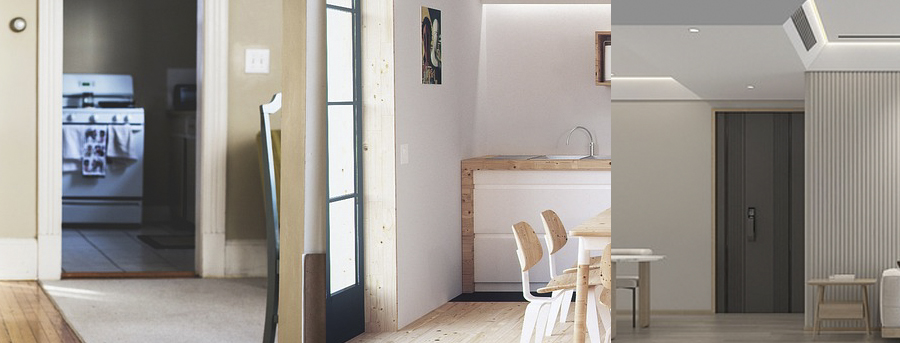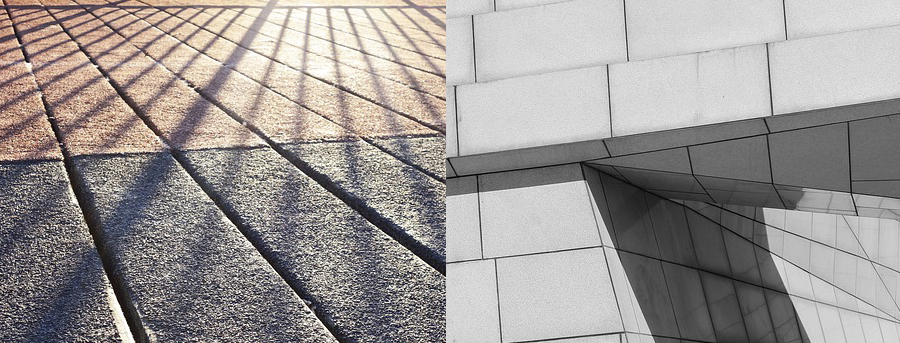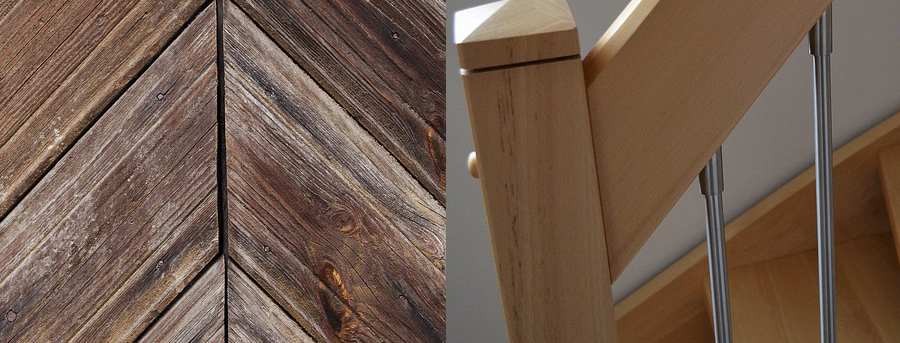Shadow gap
Contents |
[edit] What is a shadow gap ?
A shadow gap (sometimes called shadow line) is simply a gap between two surfaces, elements or materials that creates a darkened area. It can help minimise any imperfections that might otherwise be perceived more clearly were the two surfaces to be abutted directly and may also be needed to allow for movement of the materials from initial drying, such as with plaster or seasonal drying such as with timber boards which may expand and contract between wetter winter months and drier summer months.
[edit] The shadow gap Guggenheim frame
The term shadow gap is also used in picture framing to describe a picture that is inset around a frame, as opposed to the traditional method of the frame covering the edge of the picture (acting in a similar way to a cover strip or edging). The method was said to have first been used in the Guggenheim Museum, where an L section frame is laid underneath the canvas leaving a 1cm gap around the edge on the face and fixed from behind, creating a shadow gap between the exposed edge of the painting and the facing edge of the picture frame. This type of frame might also be referred to as a Guggenheim frame.
[edit] Traditional shadow gap coverings
Alternatives to shadow gaps are in architectural terms might be called cover strips, lips, edges, trims or mouldings. Many traditional architectural features were in effect acting as trims or cover strip alternatives to shadow gaps between two materials prone to movement, for example in Victorian features such as architraves. A architrave is a timber moulding that is fixed around a door frame covering the gap between the wooden frame and the plaster finished wall, it hides any imperfections that may occur between the finish or movement between the two differing materials. During this period these practical detail solutions also became architectural features of decoration matching up different materials or angles and also include cornices (covering wall to ceiling joints),skirting boards (covering wall to floor joints) and so on including all kinds of decorative trims and beads.
[edit] Modernism and the shadow gap
The modernist movement was in many respects all about stripping away what was considered decorative or unnecessary elements of a building, down to the bare essentials, as Le Corbusier would famously be quoted as saying that “modern decoration has no decoration”. In this scenario, the shadow gap may be considered to have been the preferred practical solution to a detail problem over traditional and often even modern forms of cover strips or trims. It is also true that the modernism coincided with increased possibilities in terms of fabricating the elements of buildings, which in turn facilitated greater accuracy and mechanisation. This in some respects helped to reduce tolerances and as such the need to for covers, celebrating architectural features as component parts of a "machine for living" as opposed to decorative features blending into a whole. As such the shadow gap represented the simplest, most minimal and honest way to treat the transition between units, elements, angles and surfaces.
[edit] Shadow gaps today
Today shadow gaps continue to be used as an expression of minimalism, purity and modernism, with design solutions that remove architraves from doors, and skirting from walls, leaving the simplest of lines and a stepping back of surfaces. They can be seen employed in the manufacture of all sorts of household products as well well as exterior cladding features adding to a modern aesthetic but also minimising the number of required components and increasing production efficiency.
[edit] Related articles on Designing Buildings
- Architrave.
- Acroterion.
- Barrel vault.
- Bas-relief.
- Classical orders in architecture.
- Colonnade.
- Corbel.
- Cornice.
- Cornice coving and architrave definitions.
- Door terminology.
- Elements of classical columns.
- English architectural stylistic periods.
- Entablature.
- Fillet.
- Frieze.
- Grommet.
- Lintel.
- Loggia.
- Moulding.
- Pediment.
- Pedestal.
- Pendentive dome.
- Pilaster.
- Soffit.
- Trompe l’oeil.
- Tympanum.
- Window frame.
Featured articles and news
A change to adoptive architecture
Effects of global weather warming on architectural detailing, material choice and human interaction.
How big is the problem and what can we do to mitigate the effects?
Overheating guidance and tools for building designers
A number of cool guides to help with the heat.
The UK's Modern Industrial Strategy: A 10 year plan
Previous consultation criticism, current key elements and general support with some persisting reservations.
Building Safety Regulator reforms
New roles, new staff and a new fast track service pave the way for a single construction regulator.
Architectural Technologist CPDs and Communications
CIAT CPD… and how you can do it!
Cooling centres and cool spaces
Managing extreme heat in cities by directing the public to places for heat stress relief and water sources.
Winter gardens: A brief history and warm variations
Extending the season with glass in different forms and terms.
Restoring Great Yarmouth's Winter Gardens
Transforming one of the least sustainable constructions imaginable.
Construction Skills Mission Board launch sector drive
Newly formed government and industry collaboration set strategy for recruiting an additional 100,000 construction workers a year.
New Architects Code comes into effect in September 2025
ARB Architects Code of Conduct and Practice available with ongoing consultation regarding guidance.
Welsh Skills Body (Medr) launches ambitious plan
The new skills body brings together funding and regulation of tertiary education and research for the devolved nation.
Paul Gandy FCIOB announced as next CIOB President
Former Tilbury Douglas CEO takes helm.
UK Infrastructure: A 10 Year Strategy. In brief with reactions
With the National Infrastructure and Service Transformation Authority (NISTA).
Ebenezer Howard: inventor of the garden city. Book review.
Airtightness Topic Guide BSRIA TG 27/2025
Explaining the basics of airtightness, what it is, why it's important, when it's required and how it's carried out.


























Comments
[edit] To make a comment about this article, click 'Add a comment' above. Separate your comments from any existing comments by inserting a horizontal line.